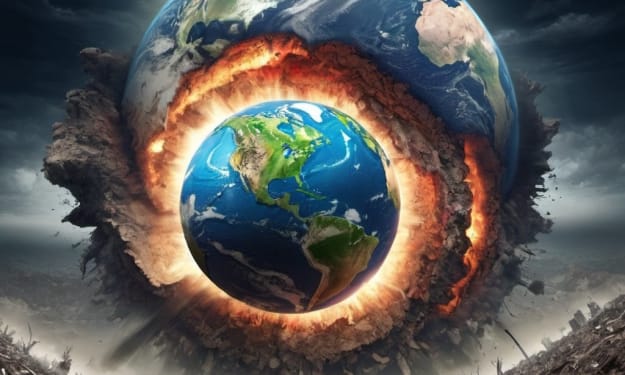Climate And Environmental Crises have Violent Consequences.
Climate change

In spite of knowing the drawn out results of an Earth-wide temperature boost, we actually neglect to lay out components that lessen nearby and worldwide discharges in the important significant degree that the most recent environment report calls for, composes the recorder.
The environment and ecological emergencies have vicious outcomes.
Annal: As often previously, the topicality of the message of the UN's environment report vanished between other news reports. So we actually need to inquire: How might we respond rapidly and by and large to something as broad as the environment and ecological emergencies?
To no one's surprise, the UN's most recent environment report got a great deal of consideration. With it, humankind got a last admonition that this decade will be definitive for whether we figure out how to remain underneath the 1.5-degree target, set in the Paris Understanding.
In any case, as oftentimes previously, the pertinence of the message vanished between other news reports. So we actually need to inquire: How might we respond rapidly and by and large to something as broad as the environment and natural emergencies?

From The Prompt To The Sluggish Acting
Our consideration is frequently attracted to prompt occasions, whether there are positive feelings connected to enormous games, for example, the five-mile in Holmenkollen or pessimistic feelings connected to difficult circumstances like conflict and mishaps.
Among the best ways of catching our consideration is brutality. Savagery makes a prompt difference, it is strong, dangerous and staggering and it frequently sets off a fast reaction. Occasions that don't have this prompt perceivability or bring out major areas of strength for intense profound feelings don't get a similar consideration.
What might seem like guiltless or customary approaches to creating society today can have appalling outcomes later on.
This is especially trying for serious occasions that reach out after some time, like an Earth-wide temperature boost and the consumption of nature.
Natural student of history Ransack Nixon depicts this as sluggish brutality: a sort of viciousness which, in contrast to war and mishaps, grows gradually, expansions in strength and is carefullyhidden. This idea offers an elective way to deal with environment and ecological obliteration, a methodology that might perhaps call for activity.
The sluggish acting brutality
Nixon presents the idea of slow brutality in the book "Slow Viciousness and the Environmentalism of Poor people". This book is roused, in addition to other things, by Rachel Carson's "Quiet Spring" (1962), which portrayed the drawn out harm brought about by the utilization of the toxin dichlorodiphenyltrichloroethane (DDT), a substance specialist for the control of 'bugs' in farming.
The specialist upset the normal equilibrium of biological systems by likewise eliminating creatures like birds, rodents, fish and debasing the dirt. Carson hence shed a significant and basic light on the drawn out risks of the utilization of such specialists, called pesticides.
A focal subject in Nixon's book on sluggish acting savagery is the test of portrayal. Slow and continuous cycles are seldom perceived as savagery, in contrast to prompt and awesome occasions. As ecological debasement is circulated in reality, it is hard to catch.

So how would you make striking stories, pictures and images that address the sluggish acting savagery?
Portrayals of quick savagery stick all the more effectively in our memory: simply consider the Buddhist priest who sets himself ablaze in challenge strict oppression in South Vietnam, or the stripped young lady who pursues towards the picture taker a napalm assault in a similar country.
The sluggish acting brutality can seldom be addressed similarly, as the transient degree makes it hard to catch the sluggish show of this kind of savagery. It is a test to make striking stories, pictures and images that catch the transient savagery of deferred impacts.
When the undetectable becomes apparent
It is not difficult to consider environment and natural changes perfect representations of slow-acting brutality. In any case, one need look no farther than a neighborhood in Lillestrøm region to track down a nearby model.
Viciousness As Characterizing Activity
What might seem like honest or conventional approaches to creating society today can have terrible outcomes later on. One just has to take a gander at the continuous obliteration of nature for motorways and extravagance lodges, or the development of wind cultivates that disregard basic liberties and native social practices.
Corruption and obliteration of nature seldom lead to quick responses. Regardless of knowing the drawn out results of an Earth-wide temperature boost, we actually neglect to lay out systems that diminish nearby and worldwide emanations in the vital significant degree that the most recent environment report calls for.
The political ability to act is frail, and measures planned to diminish a worldwide temperature alteration are as yet questionable. Simultaneously, intense episodes of viciousness, for example, the conflict in Ukraine, show that speedy responses and facilitated activity are conceivable. Maybe a nuanced translation of the expression "savagery" can assist with seeing ecological obliteration such that prompts a quick and aggregate response.






Comments
There are no comments for this story
Be the first to respond and start the conversation.